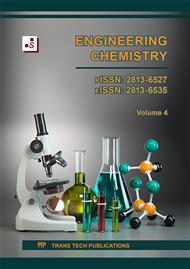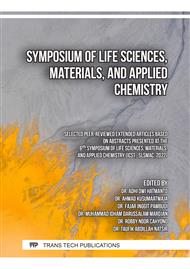[1]
N.T.T. Quyen, N.T.N. Quyen, H.T.K. Linh, T.T. Le Ngoc, H.L.T. Anh, N.H.K. Nguyen, T.H. Tran, H.N.T. Tam, M.H. Cang, Essential oil from lemon (Citrus aurantifolia) grown in Ben Tre Province, Vietnam: Condition extraction, chemical composition and antibacterial properties, Asian J. Chem. 32 (2020) 965–969.
DOI: 10.14233/ajchem.2020.22192
Google Scholar
[2]
T.T.K. Ngan, T.T. Hien, P.H. Danh, L.T.H. Nhan, L.X. Tien, Formulation of the lemongrass (Cymbopogon citratus) essential oil-based eco-friendly diffuse solution, IOP Conference Series: Materials Science and Engineering. 959 (2020) 012024.
DOI: 10.1088/1757-899x/959/1/012024
Google Scholar
[3]
T.T. Kim Ngan, N.C. Huong, X.T. Le, P.Q. Long, T.Q. Toan, D.M. Hoang Vo, V.T. Danh, L.N. Yen Trung, T.A. Trieu, Physico-chemical characteristics of Rosmarinus officinalis L. essential oils grown in Lam Dong province, Vietnam, Asian Journal of Chemistry. 31 (2019) 2759–2762.
DOI: 10.14233/ajchem.2019.22166
Google Scholar
[4]
T.K.N. Tran, T.H. Tran, T.H.N. Le, T.L. Xuan, N.Q.A. Phan, T.I. Cam, G.B. Long, Development of an aromatic wax product containing natural lemongrass (Cymbopogon citratus) essential oil, IOP Conference Series: Materials Science and Engineering. 736 (2020) 022066.
DOI: 10.1088/1757-899x/736/2/022066
Google Scholar
[5]
T.H. Tran, L.K. Ha, D.C. Nguyen, T.P. Dao, L.T.H. Nhan, D.H. Nguyen, T.D. Nguyen, D.-V.N. Vo, Q.T. Tran, L.G. Bach, The study on extraction process and analysis of components in essential oils of black pepper (Piper nigrum L.) seeds harvested in Gia Lai Province, Vietnam, Processes. 7 (2019) 56.
DOI: 10.3390/pr7020056
Google Scholar
[6]
T.H. Tran, P.T.N. Nguyen, V.T.T. Ho, T.H.N. Le, L.G. Bach, T.D. Nguyen, Using soft computing approaches for orange (Citrus nobilis Lour. var. nobilis) oils extraction process, IOP Conference Series: Materials Science and Engineering. 479 (2019) 012015.
DOI: 10.1088/1757-899x/479/1/012015
Google Scholar
[7]
T.K.N. Tran, T.H. Tran, X.T. Le, T.Q. Toan, T.T. Le Ngoc, H.L.T. Anh, M.H. Cang, Effect of storage conditions on the chemical composition of Vietnamese clove (Syzygium aromaticum) essential oil, Journal of Global Pharma Technology. 12 (2020) 447–454.
Google Scholar
[8]
B.L. GİANG, L. BACH, Evaporation compounds of Dysphania ambrosioides (L.) essential oil from Lao Cai, Vietnamese isolated by hydrodistillation, Natural Volatiles and Essential Oils. 7 (2020) 34–40.
DOI: 10.37929/nveo.780483
Google Scholar
[9]
B.L. GİANG, Extraction process optimization and compositional determination of the essential oil from pomelo (Citrus grandis L.) grown in Tien Giang Province, Vietnam, Natural Volatiles and Essential Oils. 7 (2020) 26–33.
DOI: 10.37929/nveo.780505
Google Scholar
[10]
R. Naef, The volatile and semi-volatile constituents of agarwood, the infected heartwood of Aquilaria species: A review, Flavour and Fragrance Journal. 26 (2011) 73–87.
DOI: 10.1002/ffj.2034
Google Scholar
[11]
P. Wetwitayaklung, N. Thavanapong, J. Charoenteeraboon, Chemical constituents and antimicrobial activity of essential oil and extracts of heartwood of aquilaria crassna obtained from water distillation and supercritical fluid carbon dioxide extraction, Silpakorn U Science & Technology Journal. 3 (2009) 25–33.
DOI: 10.1080/10412905.2010.9700268
Google Scholar
[12]
M. Ishihara, T. Tsuneya, K. Uneyama, Components of the volatile concentrate of agarwood, Journal of Essential Oil Research. 5 (1993) 283–289.
DOI: 10.1080/10412905.1993.9698221
Google Scholar
[13]
M. Ishihara, T. Tsuneya, M. Shiga, K. Uneyama, Three sesquiterpenes from agarwood, Phytochemistry. 30 (1991) 563–566.
DOI: 10.1016/0031-9422(91)83727-3
Google Scholar
[14]
T. Nakanishi, E. Yamagata, K. Yoneda, T. Nagashima, I. Kawasaki, T. Yoshida, H. Mori, I. Miura, Three fragrant sesquiterpenes of agarwood, Phytochemistry. 23 (1984) 2066–2067.
DOI: 10.1016/s0031-9422(00)84975-4
Google Scholar
[15]
P. Tamuli, P. Boruah, S.C. Nath, P. Leclercq, Essential oil of eaglewood tree: A product of pathogenesis, Journal of Essential Oil Research. 17 (2005) 601–604.
DOI: 10.1080/10412905.2005.9699008
Google Scholar
[16]
N.I. Bhuiyan, J. Begum, N.H. Bhuiyan, Analysis of essential oil of eaglewood tree (Aquilaria agallocha Roxb.) by gas chromatography mass spectrometry, Bangladesh Journal of Pharmacology. 4 (2009) 24–28.
DOI: 10.3329/bjp.v4i1.851
Google Scholar
[17]
N. Ismail, M.A.N. Azah, M. Jamil, M.H.F. Rahiman, S.N. Tajuddin, M.N. Taib, Analysis of high quality agarwood oil chemical compounds by means of SPME/GC-MS and Z-score technique, Malaysian Journal of Analytical Sciences. 17 (2013) 403–413.
Google Scholar
[18]
M.R. Wang, W. Li, S. Luo, X. Zhao, C.H. Ma, S.X. Liu, GC-MS study of the chemical components of different Aquilaria sinensis (lour.) gilgorgans and agarwood from different asian countries, Molecules. 23 (2018) 1–14.
DOI: 10.3390/molecules23092168
Google Scholar
[19]
P. Pripdeevech, W. Khummueng, S.K. Park, Identification of odor-active components of agarwood essential oils from Thailand by solid phase microextraction-GC/MS and GC-O, Journal of Essential Oil Research. 23 (2011) 46–53.
DOI: 10.1080/10412905.2011.9700468
Google Scholar
[20]
N. Atikah, M. Yusoff, S.N. Tajuddin, A. Hisyam, N. Adila, M. Omar, Agarwood essential oil: study on optimum parameter and chemical compounds of hydrodistillation extraction, Journal of Applied Science and Agriculture J. Appl. Sci. & Agric. 10 (2015) 1–5.
DOI: 10.33736/bjrst.223.2015
Google Scholar
[21]
S.N. Tajuddin, M.M. Yusoff, Chemical composition of volatile oils of Aquilaria malaccensis (Thymelaeaceae) from Malaysia, Natural Product Communications. 5 (2010) 1965–1968.
DOI: 10.1177/1934578x1000501229
Google Scholar
[22]
D.T.T. Thuy, T.T. Tuyen, T.T.T. Thuy, P.T.H. Minh, Q.T. Tran, P.Q. Long, D.C. Nguyen, L.G. Bach, N.Q. Chien, Isolation process and compound identification of agarwood essential oils from Aquilaria crassna cultivated at three different locations in Vietnam, Processes. 7 (2019) 432.
DOI: 10.3390/pr7070432
Google Scholar
[23]
H. Chen, Y. Yang, J. Xue, J. Wei, Z. Zhang, H. Chen, Comparison of compositions and antimicrobial activities of essential oils from chemically stimulated agarwood, wild agarwood and healthy Aquilaria sinensis (Lour.) Gilg trees, Molecules. 16 (2011) 4884–4896.
DOI: 10.3390/molecules16064884
Google Scholar
[24]
S. Kamonwannasit, N. Nantapong, P. Kumkrai, P. Luecha, S. Kupittayanant, N. Chudapongse, Antibacterial activity of Aquilaria crassna leaf extract against Staphylococcus epidermidis by disruption of cell wall, Annals of Clinical Microbiology and Antimicrobials. 12 (2013) 1–7.
DOI: 10.1186/1476-0711-12-20
Google Scholar
[25]
S.S. Dahham, Y.M. Tabana, L.E. Ahmed Hassan, M.B. Khadeer Ahamed, A.S. Abdul Majid, A.M.S. Abdul Majid, In vitro antimetastatic activity of Agarwood (Aquilaria crassna) essential oils against pancreatic cancer cells , Alexandria Journal of Medicine. 52 (2016) 141–150.
DOI: 10.1016/j.ajme.2015.07.001
Google Scholar
[26]
S.S. Dahham, L.E.A. Hassan, M.B.K. Ahamed, A.S.A. Majid, A.M.S.A. Majid, N.N. Zulkepli, In vivo toxicity and antitumor activity of essential oils extract from agarwood (Aquilaria crassna), BMC Complementary and Alternative Medicine. 16 (2016) 1–11.
DOI: 10.1186/s12906-016-1210-1
Google Scholar



